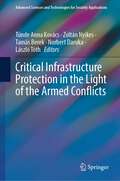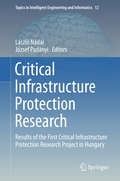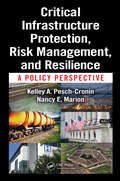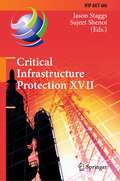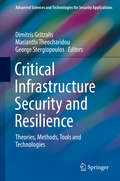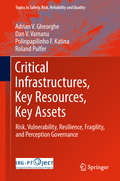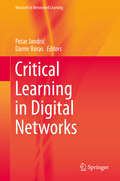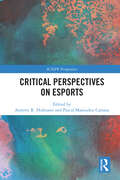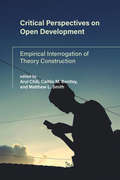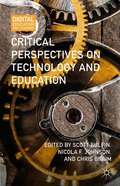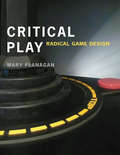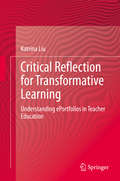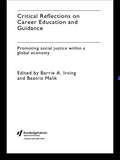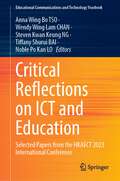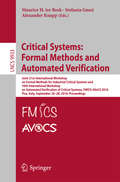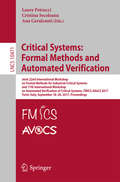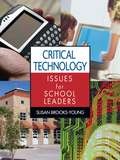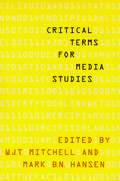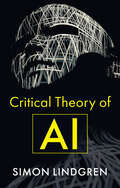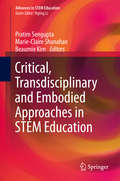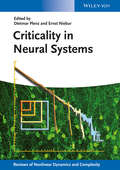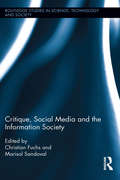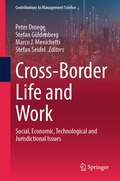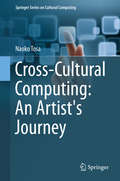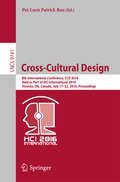- Table View
- List View
Critical Infrastructure Protection in the Light of the Armed Conflicts (Advanced Sciences and Technologies for Security Applications)
by Tünde Anna Kovács Zoltán Nyikes Tamás Berek Norbert Daruka László TóthThis book summarizes the latest findings in critical infrastructure protection and related research areas. Armed conflicts and wars are now closer to Europe than at any time in the last several decades, and the protection of critical infrastructures has gained new prominence. This situation has also revealed the vulnerability of critical infrastructure and the importance of its protection. The development of technologies, cybertechnologies, and digitalization in all aspects of our daily lives implies new security challenges in critical infrastructure protection and security science and this book addresses the four main dimensions of critical infrastructure protection: 1. Physical protection 2. Cybersecurity 3. Political security 4. Individual security The issue of physical security has accompanied humanity since its birth. Nowadays, this issue has become even more important due to technological advances, as this is the security area that people physically experience—physical protection, including protection against explosions and ballistic attacks, but also defense of objects and guaranteeing transportation security. Cyberspace represents the fifth domain of warfare and a central security question in our age. The base of cyberspace defense is high-quality hardware and expert support. With our lives increasingly digital, cybersecurity's core elements include safety awareness and informatics. Political security, the third dimension, is shaped by diverse political ideologies influencing economies, societies, and other aspects of life. This book explores topics such as migration policies, defense against terrorism, national and international security, and public safety.The fourth dimension, individual security, spans healthcare, food safety, energy supplies, and economic security. Each chapter of this book emphasizes security, focusing on Central Europe while addressing global concerns. Authored by researchers, experts, and scholars, this book is invaluable for Ph.D. students, professionals, and educators worldwide.The fourth dimension, individual security, spans healthcare, food safety, energy supplies, and economic security. Each chapter of this book emphasizes security, focusing on Central Europe while addressing global concerns. Authored by researchers, experts, and scholars, this book is invaluable for Ph.D. students, professionals, and educators worldwide. The fourth dimension, individual security, spans healthcare, food safety, energy supplies, and economic security. Each chapter of this book emphasizes security, focusing on Central Europe while addressing global concerns. Authored by researchers, experts, and scholars, this book is invaluable for Ph.D. students, professionals, and educators worldwide. The fourth dimension, individual security, spans healthcare, food safety, energy supplies, and economic security. Each chapter of this book emphasizes security, focusing on Central Europe while addressing global concerns. Authored by researchers, experts, and scholars, this book is invaluable for Ph.D. students, professionals, and educators worldwide. The fourth dimension, individual security, spans healthcare, food safety, energy supplies, and economic security. Each chapter of this book emphasizes security, focusing on Central Europe while addressing global concerns. Authored by researchers, experts, and scholars, this book is invaluable for Ph.D. students, professionals, and educators worldwide. The fourth dimension, individual security, spans healthcare, food safety, energy supplies, and economic security. Each chapter of this book emphasizes security, focusing on Central Europe while addressing global concerns. Authored by researchers, experts, and scholars, this book is invaluable for Ph.D. students, professionals, and educators worldwide. The fourth dimension, individual security, spans healthcare, food safety
Critical Infrastructure Protection Research: Results of the First Critical Infrastructure Protection Research Project in Hungary (Topics in Intelligent Engineering and Informatics #12)
by László Nádai József PadányiThis bookpresents recent research in the recognition of vulnerabilities of nationalsystems and assets which gained special attention for the CriticalInfrastructures in the last two decades. The book concentrates on R&Dactivities in the relation of Critical Infrastructures focusing on enhancingthe performance of services as well as the level of security. The objectives ofthe book are based on a project entitled "Critical InfrastructureProtection Researches" (TÁMOP-4. 2. 1. B-11/2/KMR-2011-0001) whichconcentrated on innovative UAV solutions, robotics, cybersecurity, surfaceengineering, and mechatornics and technologies providing safe operations ofessential assets. This report is summarizing the methodologies and effortstaken to fulfill the goals defined. The project has been performed by theconsortium of the Óbuda University and the National University of PublicService.
Critical Infrastructure Protection, Risk Management, and Resilience: A Policy Perspective
by Nancy E. Marion Kelley CroninCritical Infrastructure Protection and Risk Management covers the history of risk assessment, crtical infrastructure protection, and the various structures that make up the homeland security enterprise. The authors examine risk assessment in the public and private sectors, the evolution of laws and regulations, and the policy challenges facing the 16 critical infrastructure sectors. The book will take a comprehensive look at the issues surrounding risk assessment and the challenges facing decision makers who must make risk assessment choices.
Critical Infrastructure Protection XVII: 17th IFIP WG 11.10 International Conference, ICCIP 2023, Arlington, VA, USA, March 13–14, 2023, Revised Selected Papers (IFIP Advances in Information and Communication Technology #686)
by Jason Staggs Sujeet ShenoiThe information infrastructure – comprising computers, embedded devices, networks and software systems – is vital to operations in every sector: chemicals, commercial facilities, communications, critical manufacturing, dams, defense industrial base, emergency services, energy, financial services, food and agriculture, government facilities, healthcare and public health, information technology, nuclear reactors, materials and waste, transportation systems, and water and wastewater systems. Global business and industry, governments, indeed society itself, cannot function if major components of the critical information infrastructure are degraded, disabled or destroyed. Critical Infrastructure Protection XVII describes original research results and innovative applications in the interdisciplinary field of critical infrastructure protection. Also, it highlights the importance of weaving science, technology and policy in crafting sophisticated, yet practical, solutions that will help secure information, computer and network assets in the various critical infrastructure sectors. Areas of coverage include: Themes and IssuesSmart Grid Risks and ImpactsNetwork and Telecommunications Systems SecurityInfrastructure SecurityAutomobile Security This book is the seventeenth volume in the annual series produced by the International Federation for Information Processing (IFIP) Working Group 11.10 on Critical Infrastructure Protection, an international community of scientists, engineers, practitioners and policy makers dedicated to advancing research, development and implementation efforts focused on infrastructure protection. The book contains a selection of eleven edited papers from the Seventeenth Annual IFIP WG 11.10 International Conference on Critical Infrastructure Protection, which was held at SRI International, Arlington, Virginia, USA in the spring of 2023. Critical Infrastructure Protection XVII is an important resource for researchers, faculty members and graduate students, as well as for as well as for policy makers, practitioners and other individuals with interests in homeland security.
Critical Infrastructure Security and Resilience: Theories, Methods, Tools and Technologies (Advanced Sciences and Technologies for Security Applications)
by Dimitris Gritzalis Marianthi Theocharidou George StergiopoulosThis book presents the latest trends in attacks and protection methods of Critical Infrastructures. It describes original research models and applied solutions for protecting major emerging threats in Critical Infrastructures and their underlying networks. It presents a number of emerging endeavors, from newly adopted technical expertise in industrial security to efficient modeling and implementation of attacks and relevant security measures in industrial control systems; including advancements in hardware and services security, interdependency networks, risk analysis, and control systems security along with their underlying protocols.Novel attacks against Critical Infrastructures (CI) demand novel security solutions. Simply adding more of what is done already (e.g. more thorough risk assessments, more expensive Intrusion Prevention/Detection Systems, more efficient firewalls, etc.) is simply not enough against threats and attacks that seem to have evolved beyond modern analyses and protection methods.The knowledge presented here will help Critical Infrastructure authorities, security officers, Industrial Control Systems (ICS) personnel and relevant researchers to (i) get acquainted with advancements in the field, (ii) integrate security research into their industrial or research work, (iii) evolve current practices in modeling and analyzing Critical Infrastructures, and (iv) moderate potential crises and emergencies influencing or emerging from Critical Infrastructures.
Critical Infrastructures, Key Resources, Key Assets: Risk, Vulnerability, Resilience, Fragility, and Perception Governance (Topics in Safety, Risk, Reliability and Quality #34)
by Adrian V. Gheorghe Polinpapilinho F. Katina Dan V. Vamanu Roland PulferIn the face of increasing failures, comments attributed to Albert Einstein loom large: "We cannot solve our problems with the same thinking we used when we created them. " There is a pervasive feeling that any attempt to make sense of the current terrain of complex systems must involve thinking outside the box and originating unconventional approaches that integrate organizational, managerial, social, political, cultural, and human aspects and their interactions. This textbook offers research-based models and tools for diagnosing and predicting the behavior of complex techno-socio-economic systems in the domain of critical infrastructures, key resources, key assets and the open bazaar of space, undersea, and below-ground systems. These models exemplify emblematic models in physics, within which the critical infrastructures, as well as society itself and its paraphernalia, share the profile of many-body systems featuring cooperative phenomena and phase transitions - the latter usually felt as disruptive occurrences. The book and its models focus on the analytics of real-life-business actors, including policy-makers, financiers and insurers, industry managers, and emergency responders.
Critical Learning in Digital Networks (Research in Networked Learning)
by Petar Jandrić Damir BorasThis ambitious multidisciplinary volume assembles diverse critical-theory approaches to the current and future states of networked learning. Expert contributors expand upon the existing literature by analyzing the ethical aspects of networked learning and the ongoing need for more open, inclusive, and socially engaged educational practice. Chapters explore in depth evolving concepts of real and virtual, the processes of learning in, against, and beyond the internet, and the role of critical pedagogy in improving social conditions. In all, coverage is both realistic and positive about the potential of digital technologies in higher education as well as social and academic challenges on the horizon. Included among the topics: Counting on use of technology to enhance learning. Decentralized networked learning through online pre-publication. The reality of the online teacher. Moving from urban to virtual spaces and back. The project of a virtual emancipatory pedagogy. Using information technologies in the service of humanity. It is no longer a question of "Can technology enhance learning" it's a given that it does. Critical Learning in Digital Networks offers education researchers, teacher educators, instructional technologists, and instructional designers tools and methods for strengthening this increasingly vital interconnection.
Critical Perspectives on Esports (ICSSPE Perspectives)
by Annette R. Hofmann Pascal Mamudou CamaraThis book offers new, multidisciplinary perspectives on esports, one of the most rapidly growing sectors in the sports and leisure industries.Drawing on sociology, philosophy, education, business, economics, and sports science, this book considers the rise of esports, its impact on sports and society more widely, and the direction of travel for esports in the future. Featuring cutting-edge work from researchers in Europe, North America, and Asia, this book explores definitions of “esport” and “virtual sport,” and the philosophical basis by which we understand movement and embodiment in the context of digital gaming. It considers the health and well-being needs of esports athletes, across physical, mental, and social dimensions, as well as how nutrition and training relate to performance and injury prevention. This book also considers the economics of the esports industry and how the concept of sportification can be used to describe esports’ development, as well as the challenges and debates surrounding gender and representation in esports. A final section of this book looks at esports in education, in schools and universities, and considers the future of esports for a generation of digital natives.This book makes a useful contribution to the growing body of knowledge on esports and should be a thought-provoking read for anybody with an interest in sports studies, gaming, or the impact of technology on wider society.
Critical Perspectives on Open Development: Empirical Interrogation of Theory Construction (International Development Research Centre)
by Arul Chib, Caitlin M. Bentley, and Matthew L. SmithTheoretical and empirical analyses of whether open innovations in international development instrumentally advantages poor and marginalized populations.Over the last ten years, "open" innovations--the sharing of information without access restrictions or cost--have emerged within international development. But do these practices instrumentally advantage poor and marginalized populations? This book examines whether, for whom, and under what circumstances the free, networked, public sharing of information and communication resources contributes (or not) towards a process of positive social transformation. The contributors offer both theoretical and empirical analyses that cover a broad range of applications, emphasizing the underlying aspects of open innovations that are shared across contexts and domains.
Critical Perspectives on Technology and Education
by Scott Bulfin Nicola F. Johnson Chris BigumThis book offers critical readings of issues in education and technology and demonstrates how researchers can use critical perspectives from sociology, digital media, cultural studies, and other fields to broaden the "ed-tech" research imagination, open up new topics, ask new questions, develop theory, and articulate an agenda for informed action.
Critical Play: Radical Game Design
by Mary FlanaganAn examination of subversive games—games designed for political, aesthetic, and social critique.For many players, games are entertainment, diversion, relaxation, fantasy. But what if certain games were something more than this, providing not only outlets for entertainment but a means for creative expression, instruments for conceptual thinking, or tools for social change? In Critical Play, artist and game designer Mary Flanagan examines alternative games—games that challenge the accepted norms embedded within the gaming industry—and argues that games designed by artists and activists are reshaping everyday game culture. Flanagan provides a lively historical context for critical play through twentieth-century art movements, connecting subversive game design to subversive art: her examples of “playing house” include Dadaist puppet shows and The Sims. She looks at artists' alternative computer-based games and explores games for change, considering the way activist concerns—including worldwide poverty and AIDS—can be incorporated into game design.Arguing that this kind of conscious practice—which now constitutes the avant-garde of the computer game medium—can inspire new working methods for designers, Flanagan offers a model for designing that will encourage the subversion of popular gaming tropes through new styles of game making, and proposes a theory of alternate game design that focuses on the reworking of contemporary popular game practices.
Critical Reflection for Transformative Learning: Understanding e-Portfolios in Teacher Education
by Katrina LiuThis book provides a research-based guide to using ePortfolios to develop critically reflective teachers capable of transformative learning for educational equity. It begins with a conceptualization of critical reflection in teacher education, then analyzes the social discourse of prospective teachers' teaching practice through their ePortfolio reflections, triangulated by classroom teaching observations and interviews. The results of the research show that prospective teachers’ reflections are performative and do not typically trigger transformative learning, in large part because of discrepancies in the structures of the ePortfolio, the goals of the teacher education program, and the mentoring and supervisory practices. With this analysis in hand, the book turns to practical questions, providing a transformative framework along with examples and tips for teacher educators to use the author’s methods to understand and analyze prospective teachers’ reflection and support their transformative learning.
Critical Reflections on Career Education and Guidance: Promoting Social Justice within a Global Economy
by Barrie A. Irving Beatriz MalikFirst Published in 2004. Routledge is an imprint of Taylor & Francis, an informa company.
Critical Reflections on ICT and Education: Selected Papers from the HKAECT 2023 International Conference (Educational Communications and Technology Yearbook)
by Anna Wing Bo TSO Wendy Wing Lam CHAN Steven Kwan Keung NG Tiffany Shurui Bai Noble Po Kan LOThis book includes selected papers from the Hong Kong Association for Educational Communications and Technology (HKAECT) 2023 International Conference. It provides readers with a collection of insightful chapters which delves into the realms of data visualization, artificial intelligence (AI), virtual reality (VR), and augmented reality (AR). It also reflects on the dynamic shifts in online learning, blended learning, and self-directed learning. Part one of the volume includes case studies and examples of the integration of advanced technologies, such as data visualization, generative AI, and mixed reality in education. Part two shares experiences and observations from educators who embrace online learning, blended learning, and independent learning. Part three investigates the influences digital education has on learning, teaching, and society as a whole. The book paves a path for thought-provoking discussions on the future of education in a digitally connected world. It is a vital resource for educators, administrators, policymakers, and learners seeking to navigate and thrive in the rapidly evolving world of digital education.
Critical Systems: Joint 21st International Workshop on Formal Methods for Industrial Critical Systems and 16th International Workshop on Automated Verification of Critical Systems, FMICS-AVoCS 2016, Pisa, Italy, September 26-28, 2016, Proceedings (Lecture Notes in Computer Science #9933)
by Stefania Gnesi Alexander Knapp Maurice H. ter BeekThis book constitutes the refereed proceedings of the Joint 21st International Workshop on Formal Methods for Industrial Critical Systems and the 16th International Workshop on Automated Verification of Critical Systems, FMICS-AVoCS 2016, held in Pisa, Italy, in September 2016. The 11 full papers and 4 short papers presented together with one invited talk were carefully reviewed and selected from 24 submissions. They are organized in the following sections: automated verification techniques; model-based system analysis; and applications and case studies.
Critical Systems: Joint 22nd International Workshop on Formal Methods for Industrial Critical Systems and 17th International Workshop on Automated Verification of Critical Systems, FMICS-AVoCS 2017, Turin, Italy, September 18–20, 2017, Proceedings (Lecture Notes in Computer Science #10471)
by Laure Petrucci Cristina Seceleanu Ana CavalcantiThis book constitutes the refereed proceedings of the Joint 22nd International Workshop on Formal Methods for Industrial Critical Systems and the 17th International Workshop on Automated Verification of Critical Systems, FMICS-AVoCS 2017, held in Turin, Italy, in September 2017. The 14 full papers presented together with one invited talk were carefully reviewed and selected from 30 submissions. They are organized in the following sections: Automated verification techniques; Testing and scheduling; Formal Methods for mobile and autonomous robots; and Modeling and analysis techniques.
Critical Technology Issues for School Leaders
by Dr Susan J. Brooks-YoungThis resource helps school leaders focus on critical technology leadership issues and practical solutions for integrating technology into any school, administration, or professional development program.
Critical Terms for Media Studies
by W. J. T. Mitchell Mark HansenCommunications, philosophy, film and video, digital culture: media studies straddles an astounding array of fields and disciplines and produces a vocabulary that is in equal parts rigorous and intuitive. Critical Terms for Media Studiesdefines, and at times, redefines, what this new and hybrid area aims to do, illuminating the key concepts behind its liveliest debates and most dynamic topics. Part of a larger conversation that engages culture, technology, and politics, this exciting collection of essays explores our most critical language for dealing with the qualities and modes of contemporary media. Edited by two outstanding scholars in the field, W.J.T. Mitchell and Mark B.N. Hansen, the volume features works by a team of distinguished contributors.
Critical Theory of AI
by Simon LindgrenWe live in an age of artificial intelligence. Machines think and act in ever more complex ways, making suggestions and decisions on our behalf. While AI might be seen as practical and profitable, issues of data surveillance, algorithmic control, and sexist and racist bias persist. In this rapidly changing landscape, social analysis of AI risks getting scaled down to issues of ‘ethics’, ‘responsibility’, and ‘fairness’. While these are important issues, they must be addressed not from an ‘AI first’ perspective, but more thoroughly in terms of power and contention. Approaching artificial intelligence from the often overlooked perspective of critical social theory, this book provides a much-needed intervention on how both old and new theories conceptualize the social consequences of AI. Questions are posed about the ideologies driving AI, the mythologies surrounding AI, and the complex relationship between AI and power. Simon Lindgren provides a way of defining AI as an object of social and political critique, and guides the reader through a set of contentious areas where AI and politics intersect. In relation to these topics, critical theories are drawn upon, both as an argument for and an illustration of how AI can be critiqued. Given the opportunities and challenges of AI, this book is a must-read for students and scholars in the humanities, social sciences, and STEM disciplines.
Critical, Transdisciplinary and Embodied Approaches in STEM Education (Advances in STEM Education)
by Pratim Sengupta Marie-Claire Shanahan Beaumie KimOver the past decade, integrated STEM education research has emerged as an international concern, creating around it an imperative for technological and disciplinary innovation and a global resurgence of interest in teaching and learning to code at the K-16 levels. At the same time, issues of democratization, equity, power and access, including recent decolonizing efforts in public education, are also beginning to be acknowledged as legitimate issues in STEM education. Taking a reflexive approach to the intersection of these concerns, this book presents a collection of papers making new theoretical advances addressing two broad themes: Transdisciplinary Approaches in STEM Education and Bodies, Hegemony and Decolonization in STEM Education. Within each theme, praxis is of central concern including analyses of teaching and learning that re-imagines disciplinary boundaries and domains, the relationship between Art and STEM, and the design of learning technologies, spaces and environments. In addition to graduate research seminars at the Masters and PhD levels in Learning Sciences, Science Education, Educational Technology and STEM education, this book could also serve as a textbook for graduate and pre-service teacher education courses.
Criticality in Neural Systems
by Heinz Georg Schuster Dietmar Plenz Ernst NieburLeading authorities in the field review current experimental and theoretical knowledge oncriticality and brain function.The book begins by summarizing experimental evidence for criticality and self-organizedcriticality in the brain. Subsequently, important breakthroughs in modeling of critical neuronal circuits and how to establish self-organized criticality in the brain are described.A milestone publication, defining upcoming directions of research in this new fi eld and set to become the primary source of information on the brain and criticality.
Critique, Social Media and the Information Society (Routledge Studies in Science, Technology and Society)
by Christian Fuchs Marisol SandovalIn times of global capitalist crisis we are witnessing a return of critique in the form of a surging interest in critical theories (such as the critical political economy of Karl Marx) and social rebellions as a reaction to the commodification and instrumentalization of everything. On one hand, there are overdrawn claims that social media (Twitter, Facebook, YouTube, etc) have caused uproars in countries like Tunisia and Egypt. On the other hand, the question arises as to what actual role social media play in contemporary capitalism, crisis, rebellions, the strengthening of the commons, and the potential creation of participatory democracy. The commodification of everything has resulted also in a commodification of the communication commons, including Internet communication that is today largely commercial in character. This book deals with the questions of what kind of society and what kind of Internet are desirable, how capitalism, power structures and social media are connected, how political struggles are connected to social media, what current developments of the Internet and society tell us about potential futures, how an alternative Internet can look like, and how a participatory, commons-based Internet and a co-operative, participatory, sustainable information society can be achieved.
Cross-Border Life and Work: Social, Economic, Technological and Jurisdictional Issues (Contributions to Management Science)
by Peter Droege Stefan Güldenberg Marco J. Menichetti Stefan SeidelThis book discusses the risks, challenges, and opportunities of cross-border work and life from a multidisciplinary and multilevel perspective, including (a) the individual, (b) the social and organizational, and (c) the regional levels, taking into consideration the diverse and multilayered social, economic, technological, and jurisdictional issues involved.Emerging public policies and advanced information technologies (IT) have created new opportunities for work and life that thrive in global value chains and markets. Life, in general, and work, in particular, are increasingly organized across borders of various kinds and are subject to rapid change. At the same time, life and work have been determined by 19th and 20th century infrastructures and technologies. As a consequence, new strategies and measures are required for both physical and virtual work and life spaces.
Cross-Cultural Computing: An Artist's Journey (Springer Series on Cultural Computing)
by Naoko TosaThis exciting new book explores the relationship between cultural traditions and computers, looking at how people from very different cultures and backgrounds communicate and how the use of information technologies can support and enhance these dialogues. Historically we developed our understanding of other cultures through traditional means (museums, printed literature, etc. ) but the advent of information technologies has allowed us access to a plethora of material. Tosa asks the question "Can we understand other cultures using computers as media to supplement thinking and memorization?" Starting with a survey of art and technology, moving into the area of culture and technology, the book culminates with a vision of a new world based on an understanding of these relationships, allowing cultural creators and viewers the opportunity to reach a better and more profound understanding of the role information technology will play going forward.
Cross-Cultural Design: 8th International Conference, CCD 2016, Held as Part of HCI International 2016, Toronto, ON, Canada, July 17-22, 2016, Proceedings (Lecture Notes in Computer Science #9741)
by Pei-Luen Patrick RauWith the increase of globalization of business and industry, IT products and services are often produced and marketed across geographical cultural boundaries without adequate consideration of culture. There is a high probability that IT products and services developed in one country may not be effectively used in another country, which may hinder their market penetration, sales, and use. Based on research and practice, Cross-Cultural Design for IT Products and Servicesprovides a resource for human factors engineers, designers, and marketing professionals who define and develop IT products and services for the global market. With its extensive review of cross-cultural theory and cross-cultural design literature, it is also a resource for those who are interested in research on cross-cultural design. The book presents an overview of the dimensions of culture that have implications for human information processing and affective response. It examines a set of user interface design guidelines grouped into five areas: language, use of color, icons and images, navigation, and information architecture. Also, it addresses physical ergonomics and anthropometry issues. The text translates theory and guidelines into a practical methodology and discusses how to integrate methods of cross-cultural design into a standard engineering process for product development. The authors review and reappraise theories, models, principles, and techniques for design of IT products and services that will be marketed globally. They provide guidelines for user interface design across North American, Asian, and other cultures. Applying the guidelines within the methodological framework provided will enhance the usability and effectiveness of the IT product or service, and contribute to greater user satisfaction, increased productivity, higher sales, and lower product support costs.
